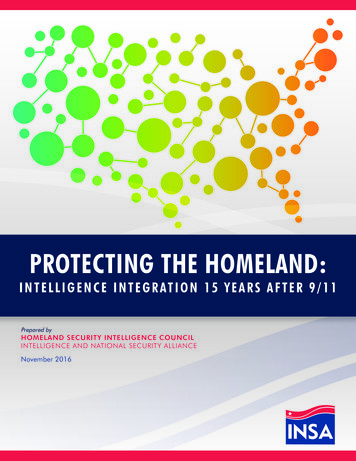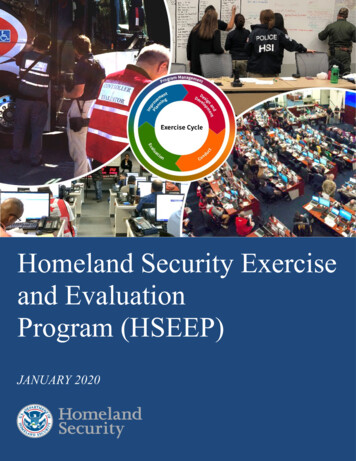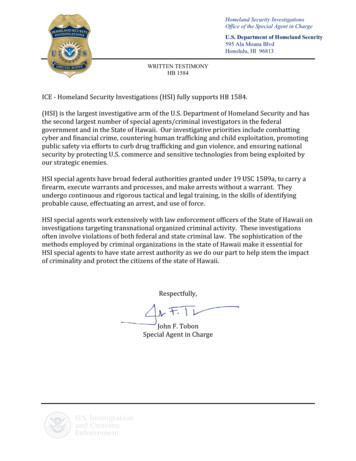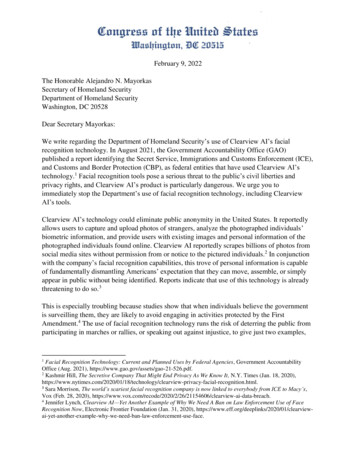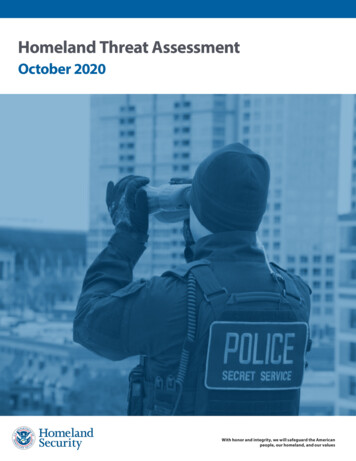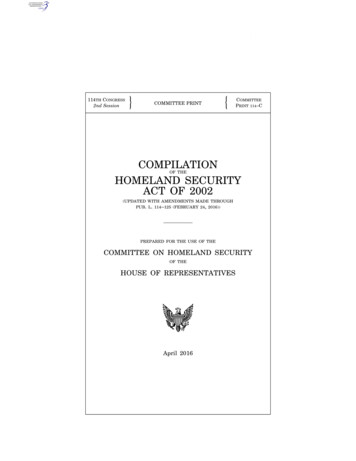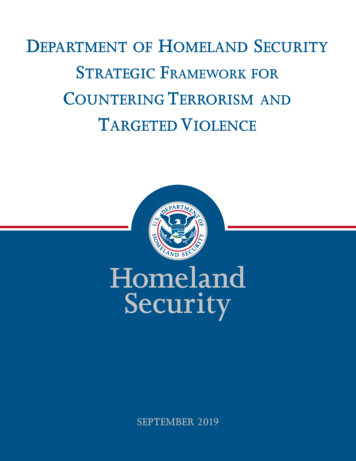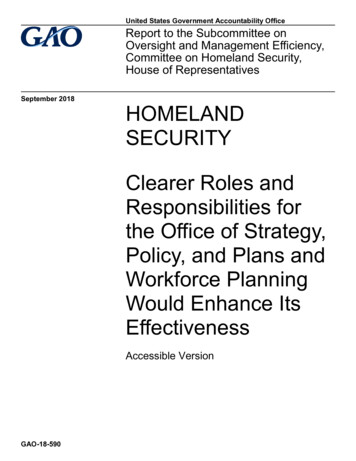
Transcription
United States Government Accountability OfficeReport to the Subcommittee onOversight and Management Efficiency,Committee on Homeland Security,House of RepresentativesSeptember 2018HOMELANDSECURITYClearer Roles andResponsibilities forthe Office of Strategy,Policy, and Plans andWorkforce PlanningWould Enhance ItsEffectivenessAccessible VersionGAO-18-590
September 2018HOMELAND SECURITYClearer Roles and Responsibilities for the Office ofStrategy, Policy, and Plans and Workforce PlanningWould Enhance Its EffectivenessHighlights of GAO-18-590, a report to theSubcommittee on Oversight and ManagementEfficiency, Committee on Homeland Security,House of Representatives.Why GAO Did This StudyWhat GAO FoundGAO has designated DHSmanagement as high risk because ofchallenges in building a cohesivedepartment. PLCY supportscohesiveness by, among other things,coordinating departmentwide policyand strategy. In the past, however,questions have been raised aboutPLCY’s efficacy. In December 2016,the NDAA codified PLCY’sorganizational structure, roles, andresponsibilities.According to our analysis and interviews with operational components, theDepartment of Homeland Security’s (DHS) Office of Strategy, Policy, and Plans’(PLCY) organizational structure and efforts to lead and coordinatedepartmentwide and crosscutting strategies—a key organizational objective–have been effective. For example, PLCY’s coordination efforts for a strategy andpolicy executive steering committee have been successful, particularly forstrategies. However, PLCY has encountered challenges leading andcoordinating efforts to develop, update, or harmonize policies that affect multipleDHS components. In large part, these challenges are because DHS does nothave clearly-defined roles and responsibilities with accompanying processes andprocedures to help PLCY lead and coordinate policy in a predictable, repeatable,and accountable manner. Until PLCY’s roles and responsibilities for policy aremore clearly defined and corresponding processes and procedures are in place,situations where the lack of clarity hampers PLCY’s effectiveness in drivingpolicy are likely to continue. Development of a delegation of authority, whichinvolves reaching agreement about PLCY’s roles and responsibilities and clearlydocumenting them, had been underway. However, it stalled due to changes indepartment leadership. As of May 2018, the effort had been revived, but it is notclear whether and when DHS will finalize it.GAO was asked to evaluate PLCY’seffectiveness. This report addressesthe extent to which (1) DHSestablished an organizational structureand processes and procedures thatposition PLCY to be effective, (2) DHSand PLCY have ensured alignment ofworkforce with priorities, and (3) PLCYhas engaged relevant component staffto help identify and respond toemerging needs. GAO analyzed theNDAA, documents describing specificresponsibilities, and departmentwidepolicies and strategies. GAO alsointerviewed officials in PLCY and alleight operational components.What GAO RecommendsGAO is making four recommendations.DHS concurred with threerecommendations, including that DHSfinalize a delegation of authoritydefining PLCY’s roles andresponsibilities and developcorresponding processes mation,concur with acontact Chris Currie at (404) 679-1875 orrecommendationtoapplythe DHSCurrieC@gao.gov.Workforce Planning Guide to identifyand communicate workforce needs.GAO believes this recommendation isPLCY does some workforce planning as part of its annual budgeting process, butdoes not systematically apply key principles of the DHS Workforce PlanningGuide to help ensure that PLCY’s workforce aligns with its and DHS’s prioritiesand goals. According to PLCY officials, the nature of its mission requires aflexible staffing approach. As such, a portion of the staff functions as generalistswho can be assigned to meet the needs of different situations, includingunexpected changing priorities due to an emerging need. However, shiftingshort-term priorities requires tradeoffs, which may divert attention and resourcesfrom longer-term priorities. As of June 5, 2018, PLCY also had a number ofvacancies in key leadership positions, which further limited attention to certainpriorities. According to PLCY officials, PLCY recently began a review to identifythe office’s authorities in the National Defense Authorization Act for Fiscal Year2017 (NDAA) and other statutes, compare these authorities to the currentorganization and operations, and address any workforce capacity gaps.Employing workforce planning principles—in particular, systematic identificationof workforce demand, capacity gaps, and strategies to address them—consistentwith the DHS Workforce Planning Guide could better position PLCY to use itsworkforce as effectively as possible under uncertain conditions and tocommunicate effectively with DHS leadership about tradeoffs.·Officials from PLCY and DHS operational components praised existingmechanisms to coordinate and communicate at the senior level, especially aboutstrategy, but component officials identified opportunities to better connect PLCYand component staff to improve communication flow about emerging policy andstrategy needs. Among the ideas offered by component officials to enhancecommunication and collaboration were holding routine small-group meetings,creating forums for periodic knowledge sharing, and maintaining accurate andup-to-date contact information for all staff-level stakeholders.United States Government Accountability Office
ContentsLetter1BackgroundPLCY Has Effectively Coordinated Intradepartmental StrategyEfforts, but Ambiguous Roles and Responsibilities Have LimitedPLCY’s Effectiveness in Coordinating PolicyPLCY Identifies Workforce Needs during the Annual BudgetCycle, but Could Apply DHS Workforce Planning Guidance toBetter Identify and Communicate Resource NeedsAdditional External Communication Practices Could EnhancePLCY’s Collaboration with DHS StakeholdersConclusionsRecommendations for Executive ActionAgency Comments and Our Evaluation4121721242425Appendix I: Comments from the Department of Homeland Security28Appendix II: GAO Contact and Staff Acknowledgements33Appendix III: Accessible Data34Agency Comment Letter34FiguresFigure 1: Department of Homeland Security’s (DHS) Office ofStrategy, Policy, and Plans and Its Sub-officesFigure 2: Examples of Overlapping Mission Areas across MultipleDepartment of Homeland Security (DHS) OperationalComponentsPage i610GAO-18-590 Homeland Security
AbbreviationsDHSDepartment of Homeland SecurityESCExecutive Steering CommitteeNDAANational Defense Authorization Act for Fiscal Year 2017PLCYOffice of Strategy, Policy, and PlansQHSRQuadrennial Homeland Security ReviewS&P ESCStrategy and Policy Executive Steering CommitteeThis is a work of the U.S. government and is not subject to copyright protection in theUnited States. The published product may be reproduced and distributed in its entiretywithout further permission from GAO. However, because this work may containcopyrighted images or other material, permission from the copyright holder may benecessary if you wish to reproduce this material separately.Page iiGAO-18-590 Homeland Security
441 G St. N.W.Washington, DC 20548LetterSeptember 19, 2018The Honorable Scott PerryChairmanThe Honorable J. Luis CorreaRanking MemberSubcommittee on Oversight andManagement EfficiencyCommittee on Homeland SecurityHouse of RepresentativesThe Department of Homeland Security (DHS) was established by theHomeland Security Act of 2002 and began operations in 2003.1 That year,we designated implementing and transforming DHS as high risk becauseDHS had to transform 22 agencies—several with major managementchallenges—into one department.2 Further, failure to effectively addressDHS’s management and mission risks could have serious consequencesfor U.S. national and economic security. Given the significant effortrequired to build and integrate a department as large and complex asDHS, our initial high-risk designation addressed the department’simplementation and transformation efforts to include associatedmanagement and programmatic challenges. We reported that thecreation of DHS was an enormous undertaking and successfullytransforming large organizations, even those undertaking less strenuousreorganizations, could take years to implement. Over the past 15 years,the focus of this high-risk area has evolved in tandem with DHS’smaturation and evolution. The overriding tenet has consistently remainedDHS’s ability to build a single, cohesive, and effective department that isgreater than the sum of its parts—a goal that requires effectivecollaboration and integration of its various components and managementfunctions.DHS’s Office of Strategy, Policy, and Plans (PLCY)3 is responsible forsome of these management functions, including developing and1See Pub. L. No. 107-296, 116 Stat. 2135 (2002), as amended.2GAO, High Risk Series: An Update, GAO-03-119 (Washington, D.C.; January 2003).3PLCY officials said they continue to use the acronym PLCY because this was theacronym used when the office was called the Office of Policy.Page 1GAO-18-590 Homeland Security
Lettercoordinating departmentwide policies and strategies, conducting analysesfor senior leadership, and supporting the Secretary’s initiatives.4 Forexample, PLCY develops and disseminates departmentwide policies inthe form of directives and instructions, strategy documents required bystatute, operational plans, and reports for Congress.5 The NationalDefense Authorization Act for Fiscal Year 2017 (NDAA), enacted inDecember 2016, established PLCY in statute.6 Although largelyconsistent with the roles and responsibilities of DHS’s Office of Policy, asPLCY was named before enactment of the NDAA, implementation of theact required organizational changes designed to respond to certainchallenges the office had identified as barriers to its ability to performeffectively.For a number of years, questions have been raised about the office’sefficacy and engagement with key stakeholders, like the DHS operationalcomponents.7 For example, we have reported on challenges related toobtaining stakeholder feedback under the office’s leadership of the 2010and 2014 Quadrennial Homeland Security Reviews (QHSR).8 We havealso reported on opportunities for select components of the office—theScreening Coordination Office and the Office of International Affairs—to4According to the DHS Strategic Planning Guidance, Fiscal Year 2017, a policy is adirective body of rules intended to set forth the overarching objective of a major initiativeor program, and a strategy articulates the vision, goals, objectives, and outcomes thatinform key budget, acquisition, and operational activities within the department, specifyingthe current problem, why the organization is particularly well-suited to address theproblem and what the organization needs to do to achieve the desired outcomes.5According to DHS, an operational plan establishes objectives and employment actionsusing existing resources to achieve a set of outcomes.6See Pub. L. No. 114-328, § 1902, 130 Stat. 2000, 2670 (2016).7The DHS operational components are the Federal Emergency Management Agency,Federal Law Enforcement Training Centers, Transportation Security Administration, U.S.Citizenship and Immigration Services, U.S. Coast Guard, U.S. Customs and BorderProtection, U.S. Immigration and Customs Enforcement, and U.S. Secret Service.8The Implementing Recommendations of the 9/11 Commission Act of 2007 required thatbeginning in fiscal year 2009 and every 4 years thereafter, the DHS Secretary shallconduct a review that provides a comprehensive examination of the homeland securitystrategy of the United States. See Pub. L. No. 110-53, § 2401, 121 Stat. 266, 543-46(2007); 6 U.S.C. § 347. For each review, the Secretary shall delineate and update, asappropriate, the national homeland security strategy, outline and prioritize the full range ofthe critical homeland security mission areas of the nation, and include an assessment ofthe organizational alignment of DHS with the homeland security strategy and missionareas, among other things. See 6 U.S.C. § 347(b)(1)-(2), (5).Page 2GAO-18-590 Homeland Security
Letterimplement better management controls to help enhance monitoring andaccountability for their respective missions.9 DHS agreed with all of ourrecommendations in those prior reports.10In light of past concerns about efficacy and the recent statutory changes,you asked us to review how PLCY is contributing to efforts to build asingle, cohesive department by driving departmentwide and crosscuttingstrategy and policy. This report addresses the extent to which (1) DHShas established an organizational structure and processes andprocedures that position PLCY to achieve its organizational objectives, (2)DHS and PLCY have ensured that PLCY’s workforce is aligned withPLCY’s and DHS’s priorities and goals, and (3) PLCY has effectivelyengaged across the operational components to identify and respond toemerging policy and strategy needs.To address all three objectives, we analyzed key documents andinterviewed officials from PLCY and other DHS offices, including officialsresponsible for policy, strategy, and plan development andimplementation at all eight of DHS’s operational components. Specifically,to better understand the roles and responsibilities of PLCY, DHS’s eightoperational components, and other offices at DHS, we reviewed theNDAA and analyzed documents, such as departmental directives thatdescribe what is required and expected of each office. In addition, weinterviewed officials from PLCY to understand its roles andresponsibilities, workforce planning practices, and collaboration with DHSoperational components.Furthermore, we interviewed officials from DHS’s Office of the UnderSecretary for Management to understand the differences betweenPLCY’s roles and responsibilities and those of the Office of the Under9GAO, Combating Terrorism: DHS Should Take Action to Better Ensure ResourcesAbroad Align with Priorities, GAO-13-681 (Washington, D.C.; Sept. 25, 2013) and CriticalInfrastructure Protection: Additional Actions by DHS Could Help Identify Opportunities toHarmonize Access Control Efforts, GAO-17-182 (Washington, D.C.; Feb. 7, 2017).10DHS has fully implemented all three recommendations from GAO-13-681. DHSestablished: 1) departmentwide priorities for resource use abroad; 2) a routine andinstitutionalized mechanism to ensure alignment of the department’s resource use abroadwith departmentwide and governmentwide strategic priorities; and 3) a common reportingframework to allow for the collecting of reliable, comparable departmentwide cost data forresource use abroad. In addition, DHS has implemented the recommendation fromGAO-17-182 directed at the Office of Policy to establish goals and objectives to support itsbroader strategic framework for harmonization of screening and access controls.Page 3GAO-18-590 Homeland Security
LetterSecretary for Management, who oversees all internal managementoperations and oversight of management functions for components atDHS headquarters. To further understand PLCY’s engagement with DHSoperational components as well as their perspectives on PLCY’s rolesand responsibilities, we conducted both unstructured and structuredinterviews with each of DHS’s eight operational components. For thestructured interviews, we developed a questionnaire that we testedinternally before administering it to DHS officials. At the structuredinterviews, we asked officials at each operational component the samequestions in the same order to ensure we collected informationconsistently and reliably across the different respondents. We comparedour findings to Standards for Internal Control in the Federal Government,leading collaboration practices identified in our prior work, and the DHSWorkforce Planning Guide to determine the extent to which PLCY is ableto achieve its goals given its organizational structure, workforce planning,and communication and collaboration with operational components.11We conducted this performance audit from July 2017 to September 2018in accordance with generally accepted government auditing standards.Those standards require that we plan and perform the audit to obtainsufficient, appropriate evidence to provide a reasonable basis for ourfindings and conclusions based on our audit objectives. We believe thatthe evidence obtained provides a reasonable basis for our findings andconclusions based on our audit objectives.BackgroundPLCY Organizational Structure and VacanciesWith the passage of the NDAA in December 2016, PLCY is to be led byan Under Secretary for Strategy, Policy, and Plans, who is appointed bythe President with advice and consent of the Senate. The UnderSecretary is to report directly to the Secretary of Homeland Security. Priorto the NDAA, the office was headed by an assistant secretary. Since the11GAO, Standards for Internal Control in the Federal Government, GAO-14-704G(Washington, D.C.: Sep. 10, 2014); Results-Oriented Government: Practices That CanHelp Enhance and Sustain Collaboration among Federal Agencies, GAO-06-15(Washington, D.C.: Oct. 21, 2005) and Managing for Results: Key Considerations forImplementing Interagency Collaborative Mechanisms, GAO-12-1022 (Washington, D.C.:Sep. 27, 2012); and Department of Homeland Security, DHS Workforce Planning Guide(Revised July 2015).Page 4GAO-18-590 Homeland Security
Letterpassage of the act, the undersecretary position has been vacant, and asof June 5, 2018, the President had not nominated an individual to fill theposition. According to PLCY officials, elevating the head of the office toan undersecretary was important because it equalizes PLCY with otherDHS management offices and DHS headquarters components. TheNDAA further authorizes, but does not require, the Secretary to establisha position of deputy undersecretary within PLCY. If the position isestablished, the NDAA provides that the Secretary may appoint a careeremployee to the position (i.e., not a political appointee).12 In March 2018,the Secretary named a Deputy Under Secretary, who has beenperforming the duties of the Deputy Under Secretary and the UnderSecretary since then. As shown in figure 1, PLCY is divided into five suboffices, each with a different focus area.12See 6 U.S.C. § 349(d). Whereas career employees compete under merit selectionprocedures and their selection is determined on the basis of their relative knowledge,skills, and abilities after fair and open competition that is intended to ensure an equalopportunity for all candidates, political employees are appointed without competition underPresidential, noncareer Senior Executive Service or Schedule C appointments, which donot confer career status.Page 5GAO-18-590 Homeland Security
LetterFigure 1: Department of Homeland Security’s (DHS) Office of Strategy, Policy, and Plans and Its Sub-officesaThe Office of Immigration Statistics, within Border, Immigration & Trade Policy, is responsible forcollecting, disseminating, and ensuring the quality of statistical information and analysis in evaluatingthe social, economic, environmental, and demographic impact of immigration laws, migration flows,and immigration enforcement.As of June 5, 2018, the top position in these sub-offices was an assistantsecretary and two of the five positions were vacant. As of June 5, 2018, 6of PLCY’s 12 deputy assistant secretary positions were vacant or filled byacting staff temporarily performing the duties in the absence of permanentstaff placement.PLCY’s Policy and Strategy Responsibilities, andStrategic PrioritiesThe NDAA codified many of the functions and responsibilities that PLCYhad been carrying out prior to the act’s enactment and, with a fewexceptions as discussed later in this report, were largely consistent withthe duties the office was already pursuing. According to the act and PLCYofficials, one of the office’s fundamental responsibilities is to lead,conduct, and coordinate departmentwide policy development andPage 6GAO-18-590 Homeland Security
Letterimplementation, and strategic planning. According to PLCY officials, thereare four categories of policy and strategy efforts that PLCY leads,conducts, or coordinates:·Statutory responsibilities: among others, the Homeland SecurityAct, as amended by the NDAA, includes such responsibilities asestablishing standards of validity and reliability for statistical datacollected by the department, conducting or overseeing analysis andreporting of such data, and maintaining all immigration statisticalinformation of U.S. Customs and Border Protection, U.S. Immigrationand Customs Enforcement, and U.S. Citizenship and ImmigrationServices; the Immigration and Nationality Act includes suchresponsibilities as providing for a system for collection anddissemination to Congress and the public of information useful inevaluating the social, economic, environmental, and demographicimpact of immigration laws, and reporting annually on trends in lawfulimmigration flows, naturalizations, and enforcement actions,13·Representing DHS in interagency efforts: coordinating orrepresenting departmental policy and strategy positions for largerinteragency efforts (e.g., interagency policy committees convened bythe White House),·Secretary’s priorities: leading or coordinating efforts that correspondto the Secretary of Homeland Security’s priorities (e.g., certainimmigration or law-enforcement related issues), and·Self-initiated activities: opportunities to better harmonize policy andstrategy or create additional efficiencies given PLCY’s ability to seeacross the department. For example, PLCY officials said that DHSobserved an increase in e-commerce and small businesses shippingitems via carriers other than the U.S. Postal Service, thus exploiting agap in DHS monitoring, which covers the U.S. Postal Service andother traditional shipping entities. PLCY officials noted that DHS’sinterest in addressing e-commerce issues occurred just before opioidsand other controlled substances were being mailed through smallbusinesses and the U.S. Postal Service. As a result, PLCY developedan e-commerce strategy for, among other things, the shipping of13See 6 U.S.C. § 349(f)(1)-(2); 8 U.S.C. § 1103(d)-(e). The NDAA amended title VII of theHomeland Security Act by adding, among other provisions, section 709—Office ofStrategy, Policy and Plans. See Pub. L. No. 114-328, § 1902(a), 130 Stat. at 2670.Pursuant to the Homeland Security Act, statutory reporting requirements, such as those inthe Immigration and Nationality Act that originated with an agency that transferred to DHS,remain in effect. See 6 U.S.C. § 552(d), (f).Page 7GAO-18-590 Homeland Security
Letterillegal items and how to provide information to U.S. Customs andBorder Protection before parcels are shipped to the United Statesfrom abroad.In accordance with the NDAA, as PLCY leads, conducts, and coordinatespolicy and strategy, it is to do so in a manner that promotes and ensuresquality, consistency, and integration across DHS and applies risk-basedanalysis and planning to departmentwide strategic planning efforts. TheNDAA further provides that all component heads are to coordinate withPLCY when establishing or modifying policies or strategic planningguidance to ensure consistency with DHS’s policy priorities. In addition tothe roles PLCY plays that are directly related to leading, conducting, andcoordinating policy and strategy, the office is responsible for selectoperational functions. For example, PLCY is charged with operating theREAL ID and Visa Waiver Programs.14The NDAA also conferred responsibilities to PLCY that had not beenresponsibilities of the DHS Office of Policy prior to the NDAA’senactment. Among other things, the NDAA charged PLCY withresponsibility for establishing standards of reliability and validity forstatistical data collected and analyzed by the department, and ensuringthe accuracy of metrics and statistical data provided to Congress. Inconferring this responsibility, the act also transferred to PLCY themaintenance of all immigration statistical information of the U.S. Customsand Border Protection, U.S. Immigration and Customs Enforcement, andU.S. Citizenship and Immigration Services.14The REAL ID Act of 2005, enacted in May 2005, addresses the recommendation by theNational Commission on Terrorist Attacks upon the United States that the federalgovernment set standards for the issuance of sources of identification, such as driver’slicenses. The act establishes minimum security standards for license issuance andproduction, and prohibits federal agencies from accepting driver’s licenses andidentification cards for certain purposes from states not meeting the act’s minimumstandards. DHS presently enforces the REAL ID Act in accordance with a phasedenforcement schedule and regulatory timeframes. The Visa Waiver Program,administered by DHS in consultation with the State Department, permits nationals of 38countries to travel to the United States for business or tourism for stays of up to 90 dayswithout a visa. In return, those 38 countries must permit U.S. citizens and nationals totravel to their countries for a similar length of time without first obtaining a visa forbusiness or tourism purposes.Page 8GAO-18-590 Homeland Security
LetterPLCY has established five performance goals:·build departmental policy-making capacity, coordination, and fosterthe Unity of Effort,15·mature the office as a mission-oriented, component-focusedorganization that is responsive to DHS leadership,·effectively engage and leverage stakeholders,·enhance productivity and effectiveness of policy personnel throughappropriate alignment of knowledge, skills, and abilities, and·accountability, transparency, and leadership.PLCY officials stated that the office established the performance goals infiscal year 2015 and they were still in effect as of fiscal year 2018.Homeland Security Crosscutting Missions and FunctionsAs previously discussed, DHS has eight operational components. DHSalso has six support components.16 Although each one has a distinct roleto play in helping to secure the homeland, there are operational andsupport functions that cut across mission areas. For example, nearlyevery operational component has, as part of its security operations, aneed for screening, vetting, and credentialing procedures and risktargeting mechanisms. Likewise, nearly all operational components havesome form of international engagement, deploying staff abroad to helpsecure the homeland before threats reach U.S. borders. Finally, as shownin figure 2, different aspects of broad mission areas fall under the purviewof more than one DHS operational component.15The Unity of Effort is a DHS initiative to synchronize major departmental planning,programming, budgeting, and joint operations decision processes—including strategydevelopment, joint requirements generation, resource allocation, acquisition management,and operational planning—to improve departmental cohesiveness and operationaleffectiveness.16The DHS support components are the Countering Weapons of Mass Destruction Office,Directorate for Management, National Protection and Programs Directorate, Office ofIntelligence and Analysis, Office of Operations Coordination, and Science and TechnologyDirectorate.Page 9GAO-18-590 Homeland Security
LetterFigure 2: Examples of Overlapping Mission Areas across Multiple Department of Homeland Security (DHS) OperationalComponentsaAlthough national preparedness is not depicted as an overlapping issue area in this figure, nationalpreparedness involves multiple parts of the department. Multiple DHS components and offices havedefined roles in the National Response Framework, which describes how the nation is to respond toemergencies. For example, the part of the National Response Framework that assigns roles fortransportation support specifically names the Federal Emergency Management Agency, U.S Customsand Border Protection, U.S. Coast Guard, Transportation Security Administration, and DHS’s Officeof Infrastructure Protection. The latter is in DHS’s National Protection and Programs Directorate,which is responsible for leading federal efforts to protect and enhance the resilience of the nation’sPage 10GAO-18-590 Homeland Security
Letterphysical and cyber infrastructure and has a number of important national preparednessresponsibilities.Key Departmentwide and Crosscutting Strategic EffortsPLCY is responsible for coordinating three key DHS strategic efforts: theQHSR, the DHS Strategic Plan, and the Resource Planning Guidance.DHS Leadership Entities PLCY Manages·The QHSR is a comprehensive examination of the homeland securitystrategy of the nation that is to occur every 4 years and includerecommendations regarding the long-term strategy and priorities forhomeland security of the nation and guidance on the programs,assets, capabilities, budget, policies, and authorities of DHS.17 TheQHSR is to be conducted in consultation with the heads of otherfederal agencies, key DHS officials (including the Under Secretary,PLCY), and key officials from other relevant governmental andnongovernmental entities.18·The DHS Strategic Plan describes how DHS can accomplish themissions it identifies in the QHSR report, identifies high-prioritymission areas within DHS, and lays the foundation for DHS toaccomplish its Unity of Effort Initiative as well as various cross-agencypriority goals in the strategic plan, such as cybersecurity.19·The Resource Planning Guidance describes DHS’s annual resourceallocation process in order to execute the missions and goals of theQHSR and DHS Strategic Plan. The Resource Planning Guidancecontains guidance over a 5-year period and informs several forwardlooking reports to Congress, inclu
appropriate, the national homeland security strategy, outline and prioritize the full range of the critical homeland security mission areas of the nation, and include an assessment of the organizational alignment of DHS with the homeland security strategy and mission area

